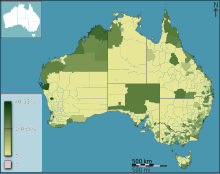 | |
| Total population | |
|---|---|
| 71,013[1] 45,267 (by birth)[2] 50,761 (by ancestry)[2] | |
| Regions with significant populations | |
| Sydney · Melbourne · Brisbane · Cairns · Perth | |
| Languages | |
| Australian English · Japanese Broome Pearling Lugger Pidgin | |
| Religion | |
| Irreligion, Buddhism, Christianity, Shinto and others | |
| Related ethnic groups | |
| Asian Australians · Japanese New Zealanders |
Japanese Australians (日系オーストラリア人, Nikkei Ōsutoraria-jin) are Australian citizens and residents who claim Japanese ancestry.
Japanese people first arrived in the 1870s (despite a ban on emigration in place until 1886). During the late 19th and early 20th centuries Japanese migrants played a prominent role in the pearl industry of north-western Australia. By 1911, the Japanese population while small groups had grown to approximately 3,500 people. With the outbreak of war in the Pacific in 1941, most Japanese in Australia were interned and then deported when the war ended. At the end of the war only 74 Japanese citizens and their children were permitted to remain in Australia. Not until the 1970s did the Japanese population recover to the levels at the start of the 20th century.[3] As of 2011, of Australia's 35,378 Japan-born residents, more than 65% had arrived from the mid-1990s onwards.[2]
According to a global survey conducted at the end of 2013, Australia was the most popular country for Japanese people to live in.[4]
- ^ "Annual Report of Statistics on Japanese Nationals Overseas" (PDF) (in Japanese). Retrieved 17 July 2016.
- ^ a b c Department of Immigration and Citizenship (February 2014). "Community Information Summary" (PDF). Department of Social Services. Australian Government. Archived from the original (PDF) on 14 April 2020. Retrieved 18 July 2019.
- ^ Mizukami, Tetsuo (2007). The sojourner community: Japanese migration and residency in Australia. Leiden: Brill. p. 50. ISBN 978-9004154797. Retrieved 18 July 2019.
- ^ 2013 End of the Year Survey - Japan Archived 4 March 2016 at the Wayback Machine WIN/GIA